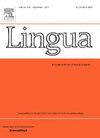基于组块的汉语动词模式重构:以判决书为例
IF 1.3
3区 文学
0 LANGUAGE & LINGUISTICS
引用次数: 0
摘要
词汇和语法模式之间的相互作用,被称为词汇语法,在描述单词的使用特征和概况方面起着至关重要的作用。词汇语法模式的提取和进一步分析是理解语言特征和使用特征的必要条件,特别是在分析单词在特定文本环境中的功能时。动词是汉语句子的句法和语义核心,因此动词模式的研究至关重要,因为各种语法元素经常与动词共存,形成稳定的高频模式,这对于全面理解汉语语言结构和意义构建既是可行的,也是必要的。以前的模式提取方法很大程度上依赖于线性一致性分析,这往往不能捕获更深层次的结构关系,导致不准确或误导性的搭配。为了克服这些局限性,本研究以中国法律判决为代表案例,引入了基于分块的标注方法。我们开发了一个框架,将谓词块分割成更细粒度的子块,从而能够精确提取动词模式。运用句法分析,我们定量地评估了动词与其语法模式之间的关联强度,并确定了首选动词模式。研究结果表明,人们对言语前模式有强烈的偏好,这与法律文本中对事实准确性和上下文特异性的特定类型要求密切相关。此外,在不同的语义动词类别(如存在、说、行动)中出现了不同的模式偏好,为汉语动词使用的句法和功能维度提供了经验见解。本研究有助于基于语料库的词汇项与语法模式相互作用的研究,加深对汉语动词使用影响因素的认识。本文章由计算机程序翻译,如有差异,请以英文原文为准。
Reframing Chinese verb patterns through a chunk-based approach: a case study of legal judgments
The interaction between lexis and grammatical patterns, known as lexicogrammar, plays a crucial role in describing a word’s usage characteristics and profiles. Lexico-grammatical pattern extraction and further analysis are essential for understanding language features and usage characteristics, particularly in analyzing how words function within specific textual contexts. Given that verbs constitute the syntactic and semantic core of Chinese sentences, investigating verb patterns is crucial, as various grammatical elements frequently co-occur with verbs to form stable and high-frequency patterns, making such research both feasible and necessary for a comprehensive understanding of Chinese linguistic structures and meaning construction. Previous methods of pattern extraction largely rely on linear concordance analyses, which often fail to capture deeper structural relationships, resulting in inaccurate or misleading collocations. To overcome these limitations, this study introduces a chunk-based annotation approach using Chinese legal judgments as a representative case study. We developed a framework to segment predicate chunks into finer-grained sub-chunks, thereby enabling precise extraction of verb patterns. Employing collostructional analysis, we quantitatively assessed the association strength between verbs and their grammatical patterns and identified preferred verb patterns. The findings demonstrate a strong preference for pre-verbal patterns, aligning closely with genre-specific requirements for factual precision and contextual specificity in legal texts. Additionally, distinct pattern preferences emerge across various semantic verb categories (e.g., existential, saying, action), providing empirical insights into the syntactic and functional dimensions of Chinese verb usage. This research contributes to corpus-based studies on the interaction between lexical items and grammatical patterns, and deepens the understanding of the factors influencing verb usage in Chinese.
求助全文
通过发布文献求助,成功后即可免费获取论文全文。
去求助
来源期刊

Lingua
Multiple-
CiteScore
2.50
自引率
9.10%
发文量
93
审稿时长
24 weeks
期刊介绍:
Lingua publishes papers of any length, if justified, as well as review articles surveying developments in the various fields of linguistics, and occasional discussions. A considerable number of pages in each issue are devoted to critical book reviews. Lingua also publishes Lingua Franca articles consisting of provocative exchanges expressing strong opinions on central topics in linguistics; The Decade In articles which are educational articles offering the nonspecialist linguist an overview of a given area of study; and Taking up the Gauntlet special issues composed of a set number of papers examining one set of data and exploring whose theory offers the most insight with a minimal set of assumptions and a maximum of arguments.
 求助内容:
求助内容: 应助结果提醒方式:
应助结果提醒方式:


